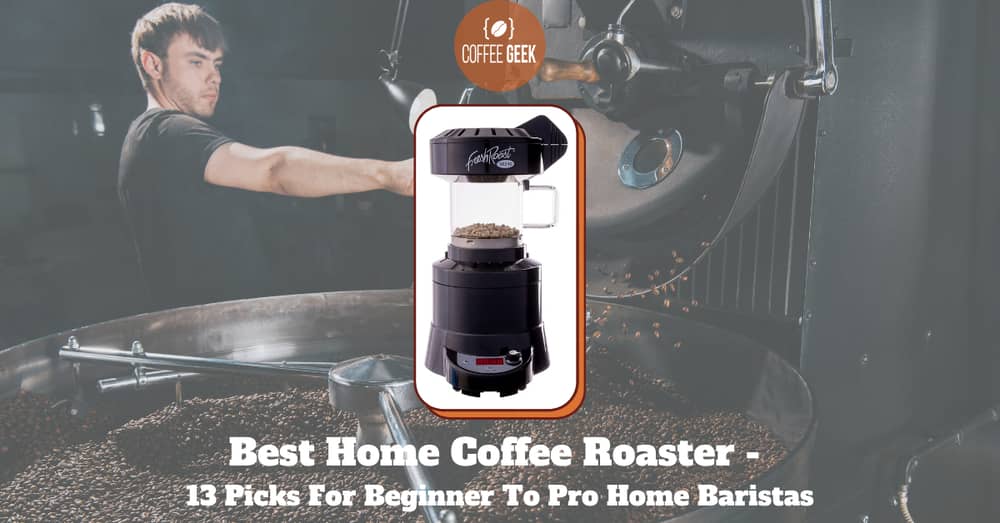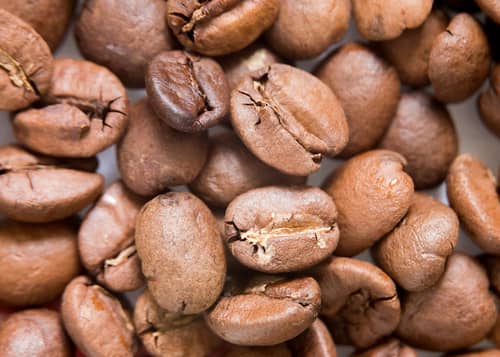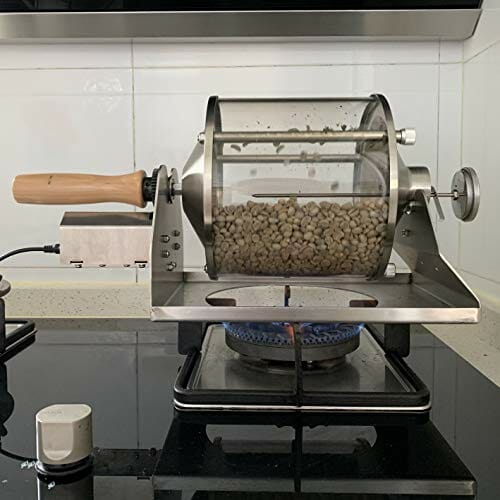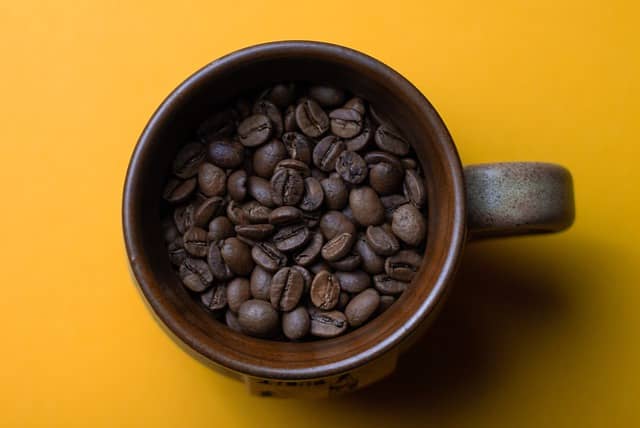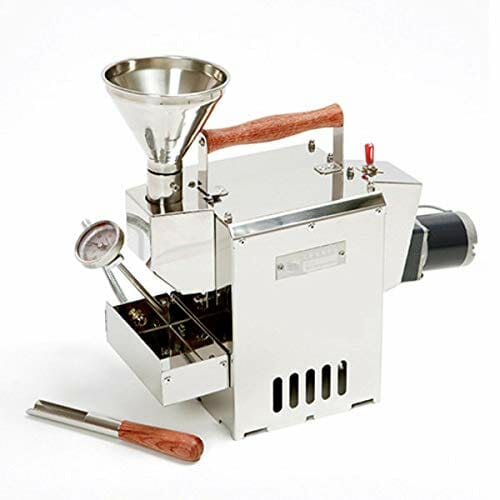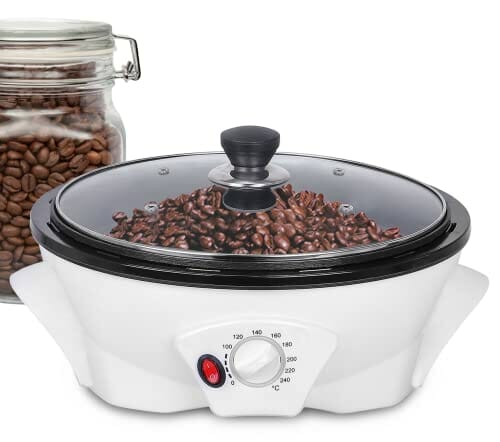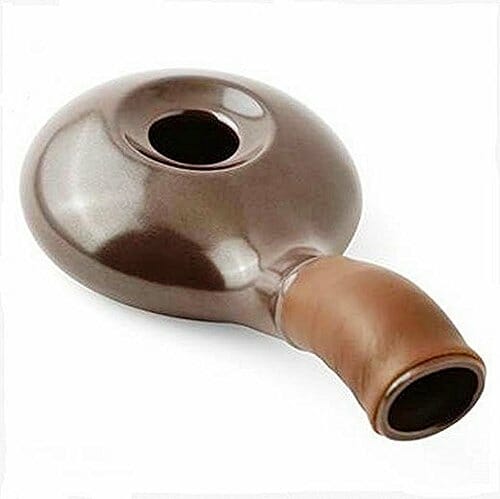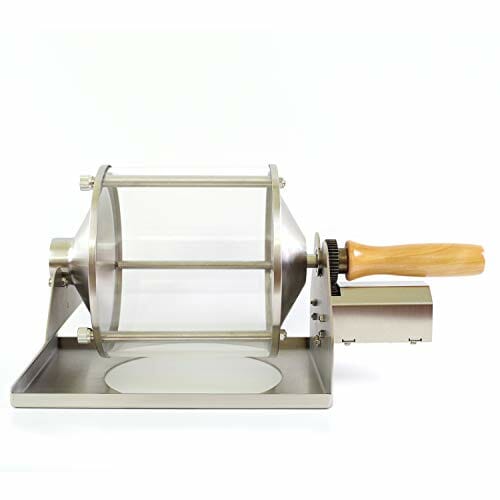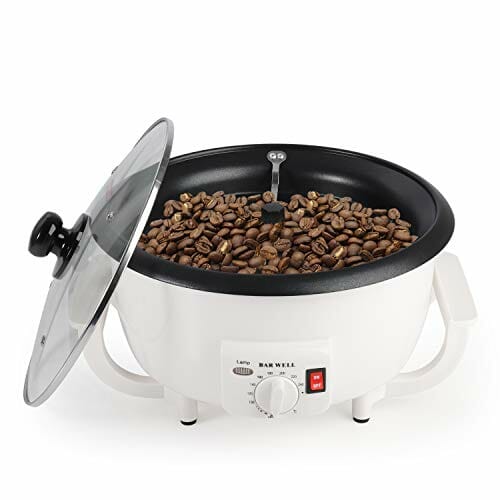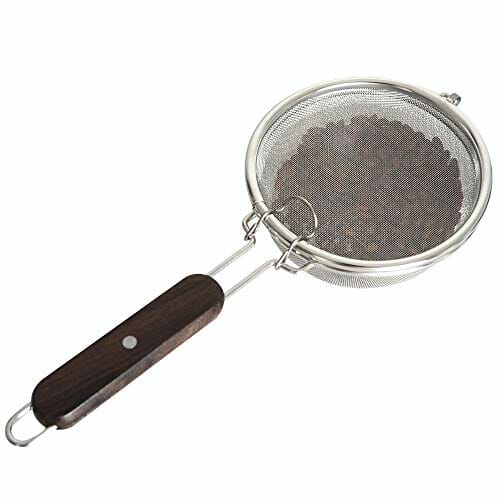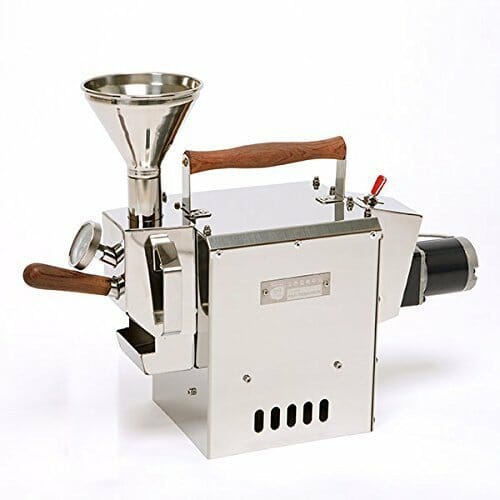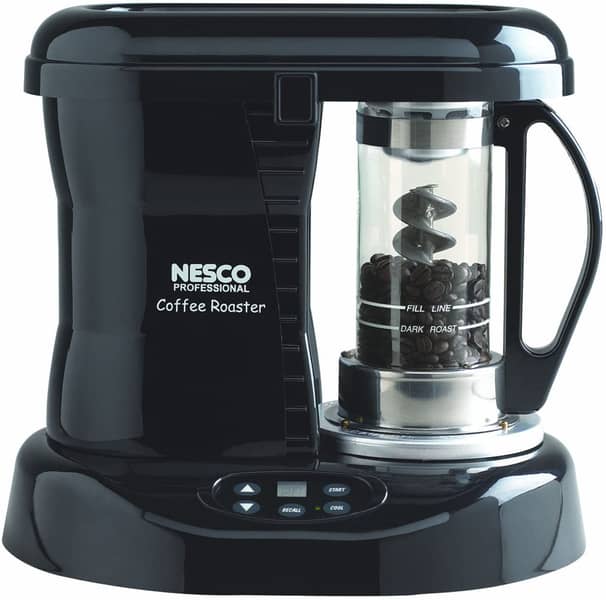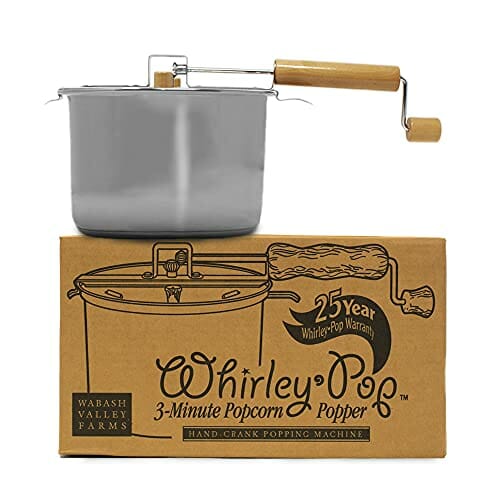Do you love coffee, especially the taste of freshly roasted coffee? Home roasting can be a fun and rewarding way to get the most out of your favorite beverage.
In this article, we’ll reveal the best home coffee roaster from the 13 top machines for beginner to pro home baristas.
Whether you’re just getting started or you’re looking for an upgrade, we’ve got you covered! So read on to learn more about these amazing machines and find the perfect one for your needs.
Can I Roast Coffee Beans At Home?
Yes, you can roast your own coffee at home! In fact, roasting your own beans is one of the best ways to guarantee that you’re getting a fresh, high-quality cup of coffee always.
Even if you’re a beginner, there are simple entry-level home coffee roasters out there that can get started.
You can even use alternatives that may already be available at home, which I’ll dive into in a little bit.
Certainly, as your skills improve (as will your love for coffee roasting), you can invest in more technical tools then.
Are Home Coffee Roasters Worth It?
It’s your call. Roasting coffee beans at home means you can:
- Save quite a bit of money (green coffee is less expensive than roasted coffee beans by half);
- Enjoy the incredible coffee aromas that escape during the roasting process;
- Gain more intimate knowledge about coffee beans;
- Get freshly roasted coffee beans for your personal use all the time.
However, roasting coffee beans is also a very tiring and messy job that requires extensive knowledge and skills about coffee roasting.
Yet, you still won’t get results as good as coffee beans roasted by commercial coffee roasters, which are widely available at local grocery stores and supermarkets and online.
So, whether all that effort is worth it or not depends on your own decision-making.
How Do I Choose A Home Coffee Roaster?
If you decide that roasting your own coffee beans at home is worth it or at least want to give it a try, here are 6 factors you should keep in mind when picking a home coffee roaster:
Type Of Home Coffee Roasters
There are 2 main types of coffee roasters that you should know:
Hot Air Roaster
With this type of roaster, the coffee beans are roasted by well-controlled hot air that circulates them, pretty similar to a popcorn maker.
This produces a very consistently even roasting result because the beans are in direct contact with the heat.
Another big plus is that the hot air roasting process can effectively remove any shedding chaff and impurities from the coffee beans (by blowing them out).
This helps prevent the coffee beans from getting roasted together with them and eventually absorbing them.
This type of roaster can also reach high temperatures in a much shorter time than others.
A shorter roasting time means fewer coffee compounds are broken down to acids like acetic and quinic, which are harsh on people with sensitive stomachs.
However, less exposure also means the coffee beans will have less caramelization and a lighter body.
And, compared to the drum coffee roaster, air roasters tend to have a lower capacity as well.
Drum Coffee Roaster
Drum roasters work by spinning the green coffee beans inside a rotating metal drum that’s heated up by an external heat source.
The coffee bean is roasted each time it meets the hot metal surface, so you can pretty much tell that it won’t be very evenly roasted.
What’s more, there’s no way to remove the shedding chaff or other impurities, so they’re likely roasted together with the beans.
This leads to more smoke and adds a (possibly undesirably) bitter and smoky undertone to the beans.
With that said, it’s still an acceptable trade-off. Drum coffee roasters are still the most popular type of professional coffee roaster due to their capability of managing a large capacity while still maintaining decent quality consistency.
Ease Of Use
You can find a wide range of automation in the market.
For coffee lovers who prioritize convenience and ease of use and don’t mind a higher price tag, getting a fully automatic roaster can get the job done quickly with minimal effort.
And, the more expensive they are, the more control and programmability they offer as well, much more than just the basic temperature and time settings.
On the other side of the spectrum, manual models are very budget-friendly, but they also require more effort and attention during the roasting process to achieve a successful batch.
Capacity
For home coffee roasting, you probably wouldn’t need a very large capacity. And, you can always upgrade down the road once you’ve nailed the craft and want to make some money out of it.
Just follow the basics I’ve mentioned earlier:
- Air roasters are more suitable for small-batch home roasting.
- Drum roasters are capable of roasting larger batches.
Smoke Suppression
As a home barista, you might want to consider a home coffee roaster that has a smoke suppression system.
This is because, without it, the smoke from the roasting process can be quite intense and overwhelming (regardless of what type of roaster you’re using), especially if you’re doing it in your kitchen.
Not only is the smoke unpleasant to breathe in, but it can also leave an unpleasant, smoky taste and odor on your coffee beans.
A smoke suppression system can help minimize the amount of smoke produced during the roasting process.
This not only makes the roasting process more pleasant for you but also allows you to better control the flavor of your coffee beans.
If you’re on a budget, you may also consider placing your roaster near a vent fan or window instead.
Cooling Feature
You should also consider getting a roaster with a good cooling feature to quickly cool down the beans after roasting.
Typically, cool air will be blown over the beans to stop the roasting process and prevent them from overcooking.
Some models even have a built-in cooling tray that the beans can be dumped into after roasting.
Price
Of course, price is always a factor to consider. You can find a wide range of prices in the market, from very affordable models to extremely expensive ones.
As previously mentioned, as a general rule of thumb, the more expensive the coffee roaster is, the better quality and features it offers.
So take your preference and budget into account when making the final decision.
13 Best Home Coffee Roasters
| Home Coffee Roaster | Product | Features | Price |
|---|---|---|---|
Best overall  |
| CHECK PRICE | |
Best drum roaster  |
| CHECK PRICE | |
Best electric roaster  |
| CHECK PRICE | |
Best manual roaster  |
| CHECK PRICE | |
Best beginner roaster  |
| CHECK PRICE | |
Best large capacity  |
| CHECK PRICE | |
Best automatic + manual roaster  |
| CHECK PRICE | |
Best straightforward roaster  |
| CHECK PRICE | |
Best intermediate roaster  |
| CHECK PRICE | |
Best roaster alternative  |
| CHECK PRICE |
Fresh Roast SR540
If you’re a beginner to the coffee roasting game, definitely check out the Fresh Roast SR540 air roaster.
It’s extremely easy to use. All you have to do is push the knob and turn it to make adjustments to the temperature, fan, and roasting time.
The updated version comes with 9 different levels of heat, compared to the previous version which only had Low, Medium, and High.
You can also easily check the current temperature via a simple turn of the knob to reveal the real-time temperature display.
The user can also change the default start settings to make it more convenient for future batches.
Keep in mind that if you have past versions of the SR roasters, the chaff basket and top lid won’t fit this one.
And, although this newest addition has a larger roasting chamber, it’s still rather small and compact, only able to handle up to 4 scoops of beans each time (120 g/4.2 oz).
Pros
- Extremely easy to use
- 9 different levels of heat and a real-time temperature display
- Easy to change the default settings for future batches
- Compact
- Quiet
- Very affordable
Cons
- The chaff basket and top lid from older versions don’t fit
- Relatively small capacity
- No smoke suppression system
Kaldi Home Coffee Roaster
This roaster has a bit of a learning curve so it’s more suitable for those who have had at least some experience up their sleeve and want to push it further.
It has both the visuals and capability to deliver great-quality roasted beans in a home setting thanks to innovative Air Roasting technology.
It’s fully motorized and has a stirring drum that can hold up to 200 – 250 g (7.1 – 8.8 oz) of raw coffee beans at once. Keep in mind that you’ll have to invest in a separate gas burner to heat it.
You can expect the Kaldi roaster to offer amazing control over basic variables such as the drum temperature, speed, and roasting time.
Plus, it also has a thermometer, a probe rod, and a chaff tray so they don’t end up getting roasted together with the beans.
The high price tag may not fit many’s budgets, but it’s a worthwhile long-term investment for those who want to stay in the game for a long time.
However, it doesn’t come with a smoke suppression system, so make sure you’re working in a well-ventilated room.
Pros
- Air Roasting technology
- Fully motorized
- Great control over the roasting variables, including temperature, speed, and time
- Comes with a thermometer, probe rod, and chaff tray
Cons
- Quite expensive
- Has a learning curve
- No smoke suppression system
Jiawanshun Electric Coffee Roaster
For those looking for something more affordable and easier to operate, consider the Jiawanshun Electric Roaster.
It has a rather large capacity with the ability to roast up to 300 – 500 g (10.6 – 17.6 oz) of raw beans at once.
But that also means it can take longer to go through a batch each time, around 20 minutes if you want a dark roast.
The user can also freely adjust the temperature between 0 – 240 degrees Celsius (33 – 464 degrees Fahrenheit) using the no-brainer one-button switch so that it’s more suitable for the type of beans they’re roasting.
One of the best features of this roaster is the transparent cover that allows you to monitor the beans as they roast.
It also has four vent holes to help with the smoke ventilation and allow you to smell the incredible aroma of freshly roasted beans during the process.
Another notable feature is the rotary bar that assists with ensuring that the beans are roasted evenly.
And, feel free to use it to roast other types of beans and nuts such as almonds, peanuts, sunflower seeds, and even popcorn.
Overall, on top of being user-friendly, it has a simplistic and modern design that’s compact enough to be moved around and tucked away.
Pros
- Affordable
- Easy to operate via the one-button temperature switch
- Has a rather large capacity
- Transparent cover with 4 vent holes
- Can be used for roasting other beans, nuts, and seeds
- Pretty compact
Cons
- May take longer to go through a batch of beans each time, due to its large capacity
- The smoke ventilation may not be sufficient for some users
Nuvo Eco Ceramic Handy Coffee Bean Roaster
For those who want more of a challenge, give manual coffee roasters a try, like this Nuvo Eco Ceramic Handy Roaster.
As you can tell from its name, it’s made of ceramic (in Korea), so you do need to be a tad bit more careful when handling it so that it wouldn’t crack or chip.
To roast beans, place the roaster on a stovetop (or gas burner), add raw beans, and manually shake it over the heat to get the job done.
There won’t be any digital timer, thermometer, or higher-end features like a cooler or smoke suppression system, so rely on your eyes, ears, roasting knowledge, and instinct.
What’s interesting is its waffle-shaped internal structure to ensure that all beans are evenly roasted.
And, due to its independence from electricity and small size (and small capacity of only 70 g/2.5 oz per batch), you can bring it anywhere, even off-the-grid, as long as you have access to open fire.
Make sure to use an oven glove to hold the handle when roasting because it can get really hot.
Pros
- Waffle-shaped internal structure ensures even roasting
- Small and portable
- Straightforward
- Can be used without electricity
Cons
- The ceramic material requires more care when handling to avoid chipping or cracking
- Need to monitor carefully from start to finish
- Pretty small capacity
- The handle can get hot during roasting
DYVEE Coffee Roaster
Another beginner-friendly roaster that you should consider is this one from DYVEE.
It’s a drum roaster that can roast up to 200 – 300 g (7.1 – 10.6 oz) of beans per batch, a good range for home roasting.
Since it’s a drum roaster, you’ll need to have a gas burner to directly heat it. Just turn it on and watch it rotate.
What’s interesting is this is a Quartz glass drum, allowing the user to check how the beans are doing throughout the process.
But, of course, that also means you need to be more careful when handling it. And it isn’t very ideal to bring on trips.
And keep in mind that you’ll have to manually adjust the heat (of the gas burner).
The roasting time can also take extremely long, possibly up to an hour. So, if you don’t have the time to stand around monitoring the beans, I suggest you look elsewhere.
Pros
- Relatively large capacity
- Made from durable quartz glass
- Easy to use and clean
Cons
- The process can take up to an hour, especially for a dark roast
- Made of vulnerable material, not suitable for trips
Behmor 1600 Plus Customizable Drum Coffee Roaster
Looking for more automatic roaster options? Check out the Behmor 1600 Plus!
It’s the first home roaster in the whole world that’s capable of roasting up to a full pound of beans (453.6 g/16 oz) at a time!
The operation is controlled by a variable speed rotating drum and thermostatically controlled quartz roasting elements to improve consistency.
The user gets to pick from 5 customizable coffee roasts settings from light roast to dark roast that can be manually overridden to suit any type of green beans!
You won’t have to worry about the shedding chaff either as the machine can effectively remove them. All you have to do is clean up the chaff tray afterward.
It’s also equipped with smoke suppression technology, making it safer for the home environment.
And there’s a cooling feature to quickly cool off the beans right after roasting, preventing them from getting overcooked.
Pros
- Very large roasting capacity
- 5 customizable roast profile settings
- Smoke suppression technology
- Automatic chaff removal
- Cooling feature to prevent overcooking
Cons
- May not produce very consistent results
- The “safety” feature may shut the machine down mid roast
MIFXIN Coffee Roaster
For those who want to roaster larger batches, look no further than the MIFXIN roaster machine!
Its pan can handle up to 750 g (26.5 oz) of green beans at once while still managing to finish the job rather quickly (around 25 minutes).
However, the recommended amount is still 300 – 500 g (10.6 – 17.6 oz) at a time only.
There’s a rotating rod on top of the non-stick pod that constantly rotates to stir the beans, ensuring that the beans are evenly roasted.
There’s also a professional thermostat that automatically maintains the appropriate roasting temperature to enhance uniformity.
And feel free to adjust the temperature throughout the process anywhere from 100 – 240 degrees Celsius (212 – 464 degrees F) to enhance precision.
Overall, it’s pretty easy to use. All you have to do is adjust the temperature and let the roasting element automatically do the job.
You’ll also enjoy the heat-resistant transparent cover with 4 holes, enabling decent ventilation and allowing you to monitor the process from start to end.
And, other than these beans, you can make the most out of this machine with other aromatic seeds and nuts as well, from popcorn to peanuts and pistachios.
Pros
- Can handle a pretty large amount of coffee at once
- A professional thermostat that automatically maintains the appropriate roasting temperature for enhanced uniformity
- Precise temperature adjustment
- Heat-resistant transparent cover with 4 venting holes
Cons
- May not last very long
- Require manual stirring
- No chaff collection
Sandbox Smart R1+C1 Home Coffee Roaster Machine
If you’re looking for a handy roaster for single-person use (or a small gathering), the electric Sandbox Smart R1+C1 is an excellent option.
Each batch of around 100 – 150 g (3.5 – 5.3 oz) can be roasted in 15 minutes. And you won’t have to go about this mindlessly either.
There’s a Sandbox Smart Coffee Roaster app that gives you step-by-step instructions and records every roasting session to help you make suitable adjustments to your future batches!
If you’re already somewhat familiar with coffee roasting, you must have heard of a roasting curve.
It’s a curve that displays the roasting temperature at each moment in time to help users assess the process.
This machine comes with 6 pre-programmed curves, but you can also create your own and get access to those created by others in the community to explore different roasting techniques!
The pros can also make the most out of this machine with its manual mode. You can adjust the heat, the damper, and fan speed to experiment and make them suit the beans you’re using better.
And, it won’t be an all-around great roaster without a chaff drawer and cooling tray!
Pros
- Convenient instructional app
- Chaff drawer and cooling tray included
- 6 pre-programmed curves
- Manual mode for advanced users
- Compact size
Cons
- Very expensive
- Small capacity
- Requires a bit of a learning curve
CAFEMASY Coffee Roasting Tool
At first glance, it looks like a regular handheld mesh filter screen but it’s actually a coffee roasting tool!
It’s made of stainless steel wire mesh with a long wooden handle to help users avoid getting burnt.
As you can tell, it’s a manual roaster. All you have to do is add 50 – 100 g (1.8 – 3.5 oz) of green beans to the net, close the buckle to prevent the beans from falling out, and shake the tool over an open fire, such as a gas stove.
The grooves at the bottom of the net help the coffee beans roll more easily to contact the heat more evenly.
And, since it’s a mesh, you can clearly observe how the beans are doing during the process.
What’s more, it’s lightweight. It’s small. It can be carried anywhere with you as long as there’s access to an open heat source.
Though it can’t roast that many beans per batch, it’s great for single-person use (or a small group). You can also roast other types of beans and nuts with it, or use it as a regular strainer.
Generally, roasting with this CAFEMASY tool takes around 8 – 15 minutes, depending on how dark you want to go.
Pros
- Affordable
- Super easy to navigate
- Easy to clean
- Lightweight and small
- Can roast other types of beans and nuts
- Can be used as a strainer
Cons
- Can only roast a very small batch of beans at a time
- Completely manual
Kaldi Wide Home Coffee Roaster
If you think the Kaldi roaster I introduced earlier has potential but find its capacity rather limited, consider getting the Kaldi Wide!
Just like the non-Wide, this version comes with a thermometer, a reliable hopper, a probe rod, and a chaff holder. But their designs are much better.
This version also has a flame arrest, which is basically a mesh plate that helps collect the chaff, stop the flame from burning the drum, and improve roasting consistency.
But, what many love about this machine is its bigger capacity. It can handle up to 300 – 350 g of beans at a time (10.6 – 12.3 oz).
This is a motorized roaster, so all you need is a gas burner to get started, which you’ll have to buy separately.
You should also get the cooler/air induction fan accessory to improve your coffee roasting experience and even increase its capacity.
However, make sure to use it either outside or somewhere with good ventilation because the smoke can get overwhelming.
Pros
- Bigger capacity than the Kaldi non-Wide roaster
- Motorized
- Has a flame arrest
- Comes with a thermometer, a reliable hopper, a probe rod, and a chaff holder for accurate roasting
Cons
- Can produce lots of smoke when used, which can make it difficult to use indoors or in poorly ventilated spaces
FreshRoast SR500 Automatic Coffee Bean Roaster
For those looking for a quiet automatic roaster, check out the FreshRoast SR500!
Like the SR540 I introduced earlier, it can handle up to 4 scoops of beans, which is around 120 g (4.2 oz) per batch.
It’s more suitable for beginners because navigation is more simplified and straightforward. It comes with only 3 temperature settings:
- High = 490 degrees Fahrenheit (254 degrees Celsius)
- Medium = 455 degrees Fahrenheit (235 degrees Celsius)
- Low = 390 degrees Fahrenheit (199 degrees Celsius)
You can also control the fan speed in 10% increments to make sure they’re evenly roasted.
Especially at the beginning of the process, the fan should be turned up high and manual stirring is required.
The user can also enjoy other common features, including chaff collection, compact size, and cooler.
However, the device can only handle up to 90 g (4 oz) of beans at a time, so it’s best for a single coffee drinker.
Pros
- Quiet
- Automatic
- Simple navigation
- Adjustable temperature and fan speed
- Chaff collection and cooler available
- Compact size
Cons
- Small capacity
- Has only 3 temperature settings
- Manual stirring can be required
Nesco CR-1010-PR Coffee Bean Roaster
If you’re really worried about the smoke and odor issue of home roasters, consider getting the Nesco CR-1010-PR.
This air roaster is equipped with state-of-the-art patented catalytic technology that can reduce the majority of the smoke and odor that’s produced during the process.
It can roast up to 1/3 lb (151.2 g/5.3 oz) of beans at a time in 20 – 30 minutes.
And, thanks to the combination of warm air and impressive agitator, the beans are moved constantly to ensure an even roast and prevent them from getting burnt.
The user wouldn’t like it if the beans came out in different colors after all.
There’s also a 5-minute cooling cycle to stop the roasting quickly.
Pros
- State-of-the-art patented catalytic technology reduces smoke and odor
- Moderate bean capacity
- Transparent roasting chamber
- Decent roasting consistency with a time setting control
- 5-minute cooling cycle afterward
- Chaff collection
- Safety cutoff switch available
Cons
- No temperature control
- The cooler may not be optimally designed for darker roasts
Wabash Valley Farms Whirley-Pop Popcorn Popper
If you don’t want to dip your whole feet into this craft, start with the toe and grab this affordable alternative instead – a popcorn roaster, especially for those who organize movie nights often.
The Wabash Valley Farms Whirley-Pop Popcorn Popper works on a stovetop (or gas burner), similar to manual roasters.
That means there will be no convenient temperature adjustment, timer, or smoke suppression function.
Just make sure to stir the beans constantly with the handle to make sure they’re evenly roasted.
But, this popcorn machine doesn’t have a transparent lid, so you’ll have to rely mainly on your ears. Catch the popping sounds to gauge the process.
Pros
- Affordable alternative
- Easy to use
- Can roast large batches
- Can make popcorn (its main function)
Cons
- Requires stirring constantly
- No temperature adjustment, timer, or smoke suppression function
- No transparent lid, so you must rely on your ears to gauge the roasting process
Our Final Verdict – The Best Home Coffee Roaster
From what I’ve tested, I find the Fresh Roast SR540 coffee roaster to be the best home coffee roaster!
Aside from its amazing user-friendliness, the amount of control and monitoring it offers is incredible as well, evident by the 9 temperature settings, real-time temperature display, and programmability.
Just make sure to use it outside or near a window to improve ventilation because there’s no smoke suppression system.
Compared to other roasters, it’s also quieter, more compact, and affordable, making it suitable for both home use and traveling.
FAQs
Is Roasting Your Own Coffee Cheaper?
Yes, it’s cheaper in the long run. Green beans cost 2 – 3 times less than roasted beans.
Though you have to invest money at the beginning to purchase the necessary equipment, there are affordable options that you can start with before upgrading as you have more knowledge and experience.
How Much Does It Cost To Buy A Coffee Roaster?
Depending on your needs, it can be anywhere as low as just $30 – $40 (manual home roaster with small capacity) to hundreds and thousands of dollars.
Usually, the more expensive it is, the better the roasting experience is, including more control, automation, and programmability.
But a commercial coffee roasting machine is in a totally different league. Think higher than $25,000.
Can You Roast Coffee Beans In A Popcorn Popper?
Yes. Though the results won’t be as great as a dedicated coffee roaster, it’s a budget-friendly alternative to start your coffee roasting journey!
We recommend getting the Wabash Valley Farms Whirley-Pop Popcorn Popper for its decent roasting ability and large capacity.
For more information, scroll upward to read our review of this product in more detail.
Can You Roast Coffee Beans In An Air Fryer?
Yes, though it’s not one of the best home coffee roasters, an air fryer can be used if you want to give home roasting a try. It’s most suitable for light roasts and medium roasts than darker roasts, however.
How Long Do Green Coffee Beans Last?
If they’re stored in a good condition (no direct sunlight and sealed packaging), a green coffee bean can last as long as a year.
Do You Wash Green Coffee Beans Before Roasting?
No, I don’t think it’s necessary to wash the raw coffee bean before roasting, especially if you’re using a proper drum roaster or hot air coffee roaster.
It may work great when making roasted beans with a stovetop pan. Washing helps remove the chaff and, despite the moisture, you can still get an even roast.
This is because it’s roasting beans from the outside to the inside.
Hot-air roasters, on the other hand, use convection in the roasting chamber to make freshly roasted whole beans from the inside out, so the moisture can affect the evenness.
And, you don’t need to remove chaff beforehand either when the home coffee bean roaster you’re using has a dedicated chaff collection feature.
Does roasting coffee smell good?
How Long Should You Roast Coffee Beans?
Generally, a small batch takes around 10 minutes, while larger ones take 20 minutes.
It depends on how much coffee you’re roasting, what type of coffee you’re using, and what kind of home coffee bean roaster you’re using.
Do I Need An Afterburner For My Roaster?
If you’re just using home coffee bean roasters, it’s not really necessary. Just roast somewhere well-ventilated or invest in a machine that comes with a smoke suppression feature.
But, if it’s a commercial roasting machine, check your local law on emissions. You likely need an afterburner to accompany your roasters.
Can You Sell Coffee That You Roast At Home?
Yes, you can, as long as you can roast some damn good coffee and find your market, which is, sadly, pretty saturated. It’ll be hard to compete against big roasters.
But, you can always start small. Make sure to check your local law and grab a license to become a seller.

